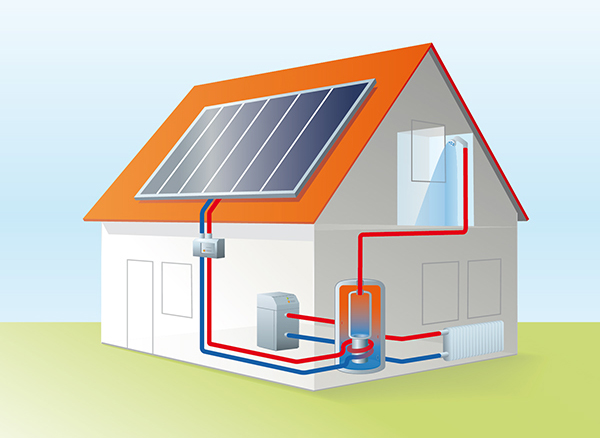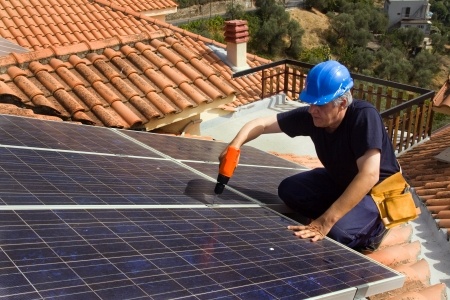There are two options for using solar energy: generating heat by using solar panels, and generating electricity using photovoltaic cells.

Solar panels convert sunlight into heat that can be used to produce hot water.
On average 1 m2surface area can collect 1000 kWh of solar energy in Poland during one year which is equivalent to 100 litres of fuel oil. This isn’t a small number but only 27% (270 kWh) of this is available during the heating season. For this reason solar installations in Poland are only viable for heating water.
It is also important to remember that this type of heating is complementary to the basic water heating system (coal or gas boiler, electric heater, electric heater in a solar tank etc.) that works also when solar energy is insufficient or unavailable.
Solar panels are one of the cleanest sources of renewable energy.

If the objective is to generate savings and achieve a quick return on the investment it is worth considering solar panels if:
In such cases the simple payback period varies from a few years to over a dozen years.
In cases when cheap fuel like coal or pellets is used and the daily average consumption of hot water is low (less than 200 litres for a 4 person family) solar energy is nevertheless worth considering for ecological reasons or to avoid having to fire up a boiler.
There are two main types of solar panels on the market: Flat plate and evacuated-tube panels. They differ not only in construction but also in the way they operate. In both cases the sunlight is collected by the absorber (a selective layer with a high absorption coefficient). The absorber is one of the most important elements of the panel because its quality defines the efficiency of the panel.

The main pros and cons of each panel type are presented in the table below.

The panels should be installed in unshaded areas and in places where they will not get dirty with leaves, dust, etc., especially if the panel is flat. The potential uses of solar panels depending on the orientation and tilt are shown in the illustration on the right.
The angle of the solar panel (measured from the horizontal to plane of the panel) has a significant impact on its performance. An optimal angle is about 37–400 facing south or south-west. A lower angle helps achieve better performance in the summer (the sun is higher and the panel is flatter), higher angles however are more effective in the winter and transitional periods. Rotating the panels towards the west will also increase the efficiency in summer although it will drop during other seasons.
What type of solar panel installation should be used for a 4 person family that consumes 240 litres of 45oC hot water daily? A comparison between evacuated (tube) and flat-plate panels is presented below.
Photovoltaics can be installed in order to have free electricity from sunlight. They are most commonly installed on roofs (see the picture on the right – system that collects electric energy).
Photovoltaic systems have features that can be as important as the ability to generate electricity.
Reliability –hotovoltaic modules are one of the most reliable sources of electric energy ever created. They have no moving parts and can last decades without maintenance.
Simplicity – photovoltaic systems contain few components and are easy to maintain and operate. They can be operated by people who have no knowledge or qualifications to operate generators powered by fossil fuel.
Modularity – under certain sunlight conditions, the amount of electric power supplied by the solar cells is to a large degree defined by the size and number of photovoltaic modules installed in the system. When more modules are installed the system generates more power. The capacity of the system can be increased according to the needs and availability of funds.
Noiseless – photovoltaic systems make no sound while in operation.

Photovoltaics are worth considering in order to reduce electricity bills. The basic pre-condition is to have a large unshaded roof surface preferably facing south.
The payback period is between a few and up to 20 years depending on the size of the installation and so should be considered long term.
Another though intangible reason for investing in photovoltaics is to be environmentally friendly as energy generated by photovoltaics reduces coal burning in Poland.

The most important aspect is to determine whether you wish to install a stand-alone system without connecting it to the electricity grid or one that is connected. The first option is more expensive because it must be integrated with an electricity storage system or batteries. The second option is cheaper but it requires agreement with the electricity supplier and a bi-directional electricity meter must be installed.
The market offers a wide range of panels of different size and capacity. Panels integrated with the roof and walls of the building are available as well as semi-transparent modules that can be installed in windows.
Photovoltaic systems installed on roofs can generate a couple of kilowatts. In theory they can support all electric equipment in a home. However in practice, due to Poland’s geographic location the amount of sunlight available is insufficient to generate enough power.
This issue can be resolved by using a system connected to the grid with a significantly larger battery and larger surface of photovoltaic panels. Unfortunately this is a very expensive solution.
When buying photovoltaic modules it is important to pay attention to the following parameters:
Power at peakis marked with Wp. It shows how much power in watts (W) can be achieved from the photovoltaic module at its peak performance. It is important to keep in mind that panels lose 0,5% of power annually.
Nominal power tolerance means that the actual power of the photovoltaic module under defined conditions will never be lower than the value declared by manufacturer, but could be a bit higher. The tolerance should always be positive and vary between 0.5% and 5%.
Brochure „Save Energy and the environment”, FEWE
Renewable energy sources. Efective use in buildings. Project financing, FEWE
http://ladnydom.pl
http://budujemydom.pl
Wspierane przez:
We współpracy z: